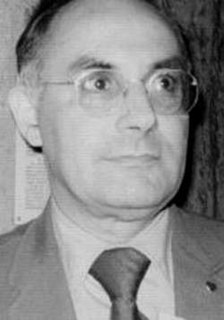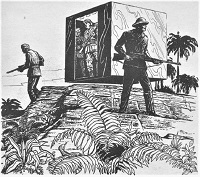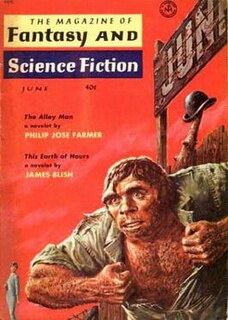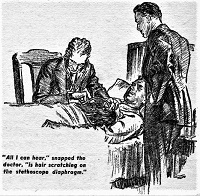The Futurians were a group of science fiction (SF) fans, many of whom became editors and writers as well. The Futurians were based in New York City and were a major force in the development of science fiction writing and science fiction fandom in the years 1937–1945.

Sam Moskowitz was an American writer, critic, and historian of science fiction.
Hiram Gilmore "Harry" Bates III was an American science fiction editor and writer. His short story "Farewell to the Master" (1940) was the basis of the well-known science fiction movie The Day the Earth Stood Still (1951).
The 1st World Science Fiction Convention (Worldcon) was held on 2–4 July 1939 in the Caravan Hall in New York City, United States, in conjunction with the New York World's Fair, which was themed as "The World of Tomorrow". It was later retroactively named "NyCon I" by Forrest J Ackerman.

Robert Duncan Milne was a late-19th century San Francisco science fiction writer whose work was published primarily in newspapers of the time, and the magazine The Argonaut. Milne was rediscovered by Sam Moskowitz, who helped collect his work in Into the Sun & Other Stories.He was born in Cupar in Scotland.

The Black Flame is a post-apocalyptic science fiction novel by American writer Stanley G. Weinbaum, originally published in hardcover by Fantasy Press in 1948.

Gertrude Barrows Bennett, known by the pseudonym Francis Stevens, was a pioneering author of fantasy and science fiction. Bennett wrote a number of fantasies between 1917 and 1923 and has been called "the woman who invented dark fantasy".
Edward Page Mitchell (1852–1927) was an American editorial and short story writer for The Sun, a daily newspaper in New York City. He became that newspaper's editor in 1897, succeeding Charles Anderson Dana. Mitchell was recognized as a major figure in the early development of the science fiction genre. Mitchell wrote fiction about a man rendered invisible by scientific means before H.G. Wells's The Invisible Man, wrote about a time-travel machine before Wells's The Time Machine, wrote about faster-than-light travel in 1874, a thinking computer and a cyborg in 1879, and also wrote the earliest known stories about matter transmission or teleportation and a superior mutant. "Exchanging Their Souls" (1877) is one of the earliest fictional accounts of mind transfer. Mitchell retired in 1926, a year before dying of a cerebral hemorrhage.

"A Gun for Dinosaur" is a time travel science fiction story by American writer L. Sprague de Camp as part of his Rivers of Time series. It tells the story of four men who travel into the past to hunt dinosaurs.

"The Alley Man" is a science fiction short story by American writer Philip José Farmer. The story tells of the life of Old Man Paley, who may — or may not — be the last Neanderthal, still alive in the 20th century.
Uncanny Tales was a Canadian science fiction pulp magazine edited by Melvin R. Colby that ran from November 1940 to September 1943. It was created in response to the wartime reduction of imports on British and American science-fiction pulp magazines. Initially it contained stories only from Canadian authors, with much of its contents supplied by Thomas P. Kelley, but within a few issues Colby began to obtain reprint rights to American stories from Donald A. Wollheim and Sam Moskowitz. Paper shortages eventually forced the magazine to shut down, and it is now extremely rare.

Science Fiction in Old San Francisco: Volume Two, Into the Sun & Other Stories is a collection of science fiction short stories by Robert Duncan Milne and edited by Sam Moskowitz. It was first published in 1980 by Donald M. Grant, Publisher, Inc. in an edition of 1,500 copies. All but one of the stories first appeared in the magazine The Argonaut. The other story, "A Question of Reciprocity" first appeared in the San Francisco Examiner. This book with its companion volume History of the Movement From 1854 to 1890 won a Pilgrim Award for its editor, Moskowitz, in 1981.

The Haunted Pampero is a collection of fantasy and other short stories by William Hope Hodgson. It was first published in 1992 by Donald M. Grant, Publisher, Inc. in an edition of 500 copies, all of which were signed by the editor, Sam Moskowitz. The stories first appeared in the magazines The Premier Magazine, The Red Magazine, Cornhill Magazine, The Idler, Shadow: Fantasy Literature Review, The Royal Magazine, The Blue Magazine, Sea Stories, The New Age, Everybody’s Weekly and Short Stories.

Science-Fiction Plus was an American science fiction magazine published by Hugo Gernsback for seven issues in 1953. In 1926, Gernsback had launched Amazing Stories, the first science fiction magazine, but he had not been involved in the genre since 1936, when he sold Wonder Stories. Science-Fiction Plus was initially in slick format, meaning that it was large-size and printed on glossy paper. Gernsback had always believed in the educational power of science fiction, and he continued to advocate his views in the new magazine's editorials. The managing editor, Sam Moskowitz, had been a reader of the early pulp magazines, and published many writers who had been popular before World War II, such as Raymond Z. Gallun, Eando Binder, and Harry Bates. Combined with Gernsback's earnest editorials, the use of these early writers gave the magazine an anachronistic feel.

Satellite Science Fiction was an American science-fiction magazine published from October 1956 to April 1959 by Leo Margulies' Renown Publications. Initially, Satellite was digest sized and ran a full-length novel in each issue with a handful of short stories accompanying it. The policy was intended to help it compete against paperbacks, which were taking a growing share of the market. Sam Merwin edited the first two issues; Margulies took over when Merwin left and then hired Frank Belknap Long for the February 1959 issue. That issue saw the format change to letter size, in the hope that the magazine would be more prominent on newsstands. The experiment was a failure and Margulies closed the magazine when the sales figures came in.

"The Gnarly Man" is a science fiction story by American writer L. Sprague de Camp, about an apparently immortal Neanderthal Man surviving into the present day.

Comet was a pulp magazine which published five issues from December 1940 to July 1941. It was edited by F. Orlin Tremaine, who had edited Astounding Stories, one of the leaders of the science fiction magazine field, for several years in the mid-1930s. Tremaine paid one cent per word, which was higher than some of the competing magazines, but the publisher, H-K Publications based in Springfield, MA, was unable to sustain the magazine while it gained circulation, and it was cancelled after less than a year when Tremaine resigned. Comet published fiction by several well-known and popular writers, including E.E. Smith and Robert Moore Williams. The young Isaac Asimov, visiting Tremaine in Comet's offices, was alarmed when Tremaine asserted that anyone who gave stories to competing magazines for no pay should be blacklisted; Asimov promptly insisted that Donald Wollheim, to whom he had given a free story, should make him a token payment so he could say he had been paid.

Modern Masterpieces of Science Fiction is an anthology of science fiction short stories, edited by Sam Moskowitz. It was first published in hardcover by World Publishing Co. in 1965, and reprinted by Hyperion Press in 1974. It was split into three separate paperback anthologies published by MacFadden-Bartell; Doorway Into Time (1966), The Vortex Blasters (1968) and Microcosmic God (1968); the paperback editions omitted Moskowitz's introduction and the story by Robert Bloch.

"The Stolen Dormouse" is a science fiction novella by American writer L. Sprague de Camp. It was first published as a serial in the magazine Astounding Science-Fiction for April and May, 1941 and first appeared in book form in de Camp's collection Divide and Rule. The story has also appeared in the anthologies Astounding Stories: The 60th Anniversary Collection, and The Best of Astounding: Classic Short Novels from the Golden Age of Science Fiction.

"Hyperpilosity" is a science fiction story by American writer L. Sprague de Camp. It was first published in the magazine Astounding Stories for April, 1938, and first appeared in book form in the de Camp collection The Wheels of If and Other Science Fiction (Shasta, 1949; It later appeared in the anthologies Omnibus of Science Fiction, Science Fiction of the Thirties, The Edward De Bono Science Fiction Collection, and The Road to Science Fiction #2: From Wells to Heinlein, as well as the magazine Fantastic Story Magazine and the de Camp collection The Best of L. Sprague de Camp. In 2014 the story was shortlisted for the Retro Hugo Award for Best Short Story.















